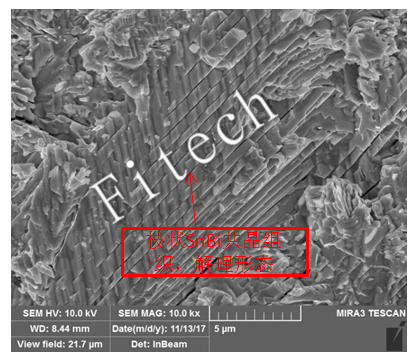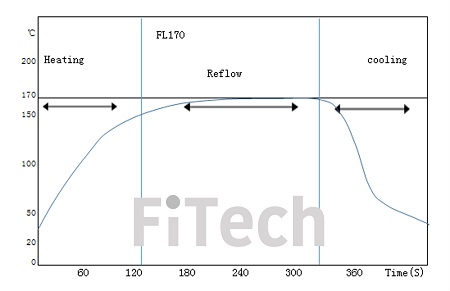Three Technical Routes to Improve The Reliability of Low-Temperature Lead-Free Solder Paste - Principle of High Strength Low Temperature Solder Paste
Abstract
With the trend of thin and light electronic components, the original lead-free solder paste products for electronic and semiconductor packaging such as SAC305, SAC0307, and other lead-free solder paste products can no longer meet the requirements of modern electronic product packaging. The traditional low-temperature lead-free tin-bismuth-based solder paste Sn42Bi58 has the phenomenon of bismuth enrichment at the soldering interface (as shown in Figure 1, note: the property that grains often crack in a certain direction and produce a smooth plane after being stressed is called cleavage), resulting in low soldering strength. Therefore, the reliability of traditional low-temperature lead-free Sn42Bi58 solder paste is difficult to adapt to the complex application environments of high-end electronic products. Fitech's low-temperature high-reliability lead-free FT\FSA\FL series solder paste, epoxy solder paste, and solder powder products adopt a new composite reinforcement route. As a result, it effectively improves the soldering reliability. The thrust strength of solder joints is close to that of SAC305 solder paste.

In 2016, under the call of an international well-known chip company, many companies and research institutions invested a lot of manpower and material resources in low-temperature high-reliability lead-free solder research and development. People were looking for a low-temperature lead-free alloy with low reflow soldering temperature similar to Sn63Pb37 solder paste and high soldering reliability like Sn63Pb37 solder paste and SAC305 solder paste. The metal phase properties of lead-free alloy dominate the available options of solder paste alloys. Hence, the available alloys for the lead-free solder industry are very limited. After nearly six years of hard work, scientists and engineers have finally opened up several feasible technical routes to improve the reliability of lead-free low-temperature solder past, basically realizing the purposes of low temperature and high-reliability soldering.
Figure 1: Cleavage of Sn42Bi58 solder paste.
The metal phase diagram dominates the choices of low-temperature high-reliability lead-free solder paste solder. At this stage, the best route is to keep using the original low-temperature lead-free tin-bismuth alloy, combined with different solder paste improvement methods to enhance the bismuth-rich phenomenon near the intermetallic compound (IMC) of the alloy solder joints. It can strengthen the solder joints and reduce the thickening of IMC in a complex environment. There are currently three main technical routes:
The first route is to add other reinforcement trace elements such as nickel (Ni), antimony (Sb), cobalt (Co), copper (Cu), silver (Ag), and cerium (Ce) to the low-temperature lead-free Sn42Bi58 alloy. It forms solid solution particles near the IMC during reflow soldering to change the metallographic structure of the tin-bismuth eutectic alloy in the solder paste. As a result, it can realize the solid solution strengthening of the metallographic structure and the dispersion strengthening of trace element particles. In the complex reliability testing environment, the bismuth-rich phenomenon near the IMC of the solder joint was improved. The metallographic structure was also enhanced.
The second route is the use of composite solder technology. Organic synthetic resin is added to the flux of the original low-temperature lead-free Sn42Bi58 solder paste. The organic synthetic resin produces a cross-linking reaction of organic groups when the Sn42Bi58 alloy is melted and solidified. It forms composite solder joints with synthetic resin outside and alloy solder joints inside. Due to the protection of synthetic resin in the solder paste, the solder joints can achieve high insulation resistance value and high solder strength. The downsides are that the cost of solder increases, and the process performance is limited.
The last route is the new composite solder method adopted by Fitech. Micro/nanopowders containing tin (Sn), silver (Ag), indium (In), copper (Cu), antimony (Sb), cobalt (Co), cerium (Ce), and other elements are added to the low-temperature lead-free Sn42Bi58 alloy powder. These powders of various sizes are mixed with flux to form a solder paste. This mixed solder paste generates a "flat head" reflow profile during the reflow process below 210°C (as shown in Figure 2). The low-temperature Sn42Bi58 eutectic alloy completes a micro-metallurgical process during reflow soldering at the peak reflow temperature, forming a new solder joint alloy structure called hypoeutectic tin-bismuth alloy. This alloy structure has several features:

①.Sn42Bi58 eutectic alloy is likely to generate a bismuth-rich layer (brittle structure) during the melting process because of the low solid solution content of tin in liquid bismuth (21%). Tin is easy to precipitate and interface with the copper surface of the soldering pad, forming SnCu compounds. In this regard, Fitech is the first to add elemental micro/nano-tin in the solder paste formula. Due to the addition of elemental nano-tin, the copper pad preferentially reacts with elemental nano-tin to form a new IMC structure, preventing the precipitation of tin in the Sn42Bi58 eutectic alloy near the IMC of the solder joints and ensuring a compositional balance of solder paste. This method of forming a new IMC through the reaction of elemental micro/nano-tin in the solder paste with the copper pad is called the "occupancy" method. The "occupancy" method prevents the precipitation of tin in the solder paste alloy to ensure the metallographic stability of the Sn42Bi58 eutectic alloy. It also eliminates the dendritic eutectic formation by the segregation of bismuth. It is believed that eutectic is the main reason for the brittle solder joint formation.
②.Due to the dispersion and the solid solution strengthening of nanoparticles such as antimony (Sb), silver (Ag), copper (Cu), indium (In), cobalt (Co), and cerium (Ce) in the solder paste, the growth and segregation of grains in the tin-bismuth eutectic alloy in the solder joint are blocked. In the follow-up reliability experiments in complex environments, the growth rate of IMC in the solder joint structure formed by the new composite solder is slow, and a bismuth-rich layer in a strip shape will not form near the solder joints. Thus, the reliability of solder joints is high.
③.So far, the low-temperature solder reliability test results organized by the International Electronics Manufacturing Alliance (iNEM) show that the low-temperature lead-free composite solder paste and epoxy solder paste have high shock resistance. Besides, the test data show that the shock resistance of composite solder paste is close to that of the traditional SAC305 solder paste. Fitech’s experimental data have also confirmed the theoretical inferences above. The data of high temperature and high humidity reliability test shows that the Fitech’s composite low-temperature lead-free solder paste and epoxy solder paste can produce solder joints with thrust equivalent to 85% of the thrust of traditional SAC305 solder paste solder joints, while the IMC thickness is smaller than that of SAC305 solder paste.
Summary
The development of composite low-temperature lead-free solder paste and epoxy solder paste depends on the joint efforts of scientists and engineers in the global solder industry. The composite solder paste successfully meets the goal of high-strength and high-reliability soldering under the peak reflow temperature of less than 210°C. Fitech's invention patent called "Micro/nanoparticle-reinforced composite solder and its preparation method 201711280945.3" has been authorized by the Chinese Patent Office on October 23, 2020. Fitech has applied for PCT, and the application has entered the stage of actual examination in the United States and Japan. Fitech’s low-temperature high-reliability lead-free composite solder paste is the first to be popularized and applied in the global microelectronics and semiconductor industries. It has become the mainstream technology and product of low-temperature high-reliability lead-free packaging in the global electronic packaging industry. The composite solder method has become the mainstream of low-temperature high-reliability lead-free solder paste development.
-End-











 Back to list
Back to list



